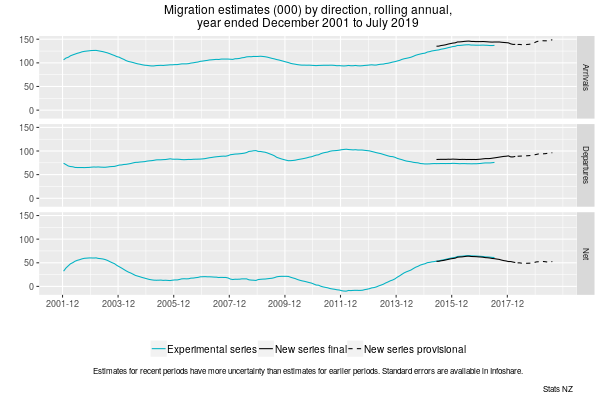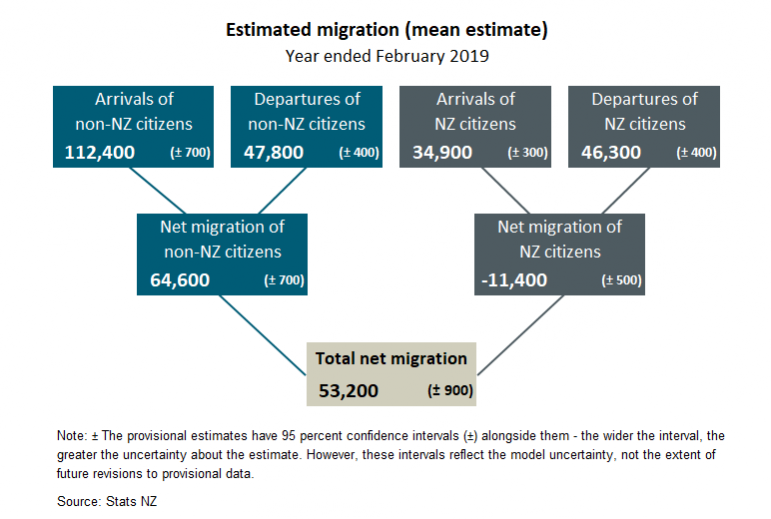Annual net migration was provisionally estimated at 53,200 (± 900) in the year ended February 2019 compared with 51,500 in the previous year, Stats NZ said today.
"Increases for both migrant arrivals and migrant departures meant that there was a slight increase in net migration in the year ended February 2019," population indicators manager Tehseen Islam said.
"Annual net migration has fluctuated between 49,000 and 55,000 since the year ended October 2017."
Migrant arrivals are overseas residents, including New Zealand citizens, who cumulatively spend 12 of the next 16 months in New Zealand after arriving.
Migrant departures are New Zealand residents, including non-New Zealand citizens, who cumulatively spend 12 of the next 16 months out of New Zealand after departing.

Provisional migrant arrivals were up 8,300 to 147,300 in the year ended February 2019. The top source countries for arrivals were:
- Australia (25,800 - 15,600 of which were New Zealand citizens)
- China (15,800)
- India (12,300).
Provisional estimates of migrant departures were up 6,500 to 94,100.
Citizenship
The growth in overall migrant arrivals (8,300) was driven by non-New Zealand citizen arrivals. There were 9,300 more migrant arrivals of non-New Zealand citizens in the year ended February 2019 compared with the year ended February 2018. Migrant arrivals of New Zealand citizens were down 1,000.

Text alternative for diagram, Estimated migration (mean estimate), year ended February 2019
In contrast, the growth in overall migrant departures (6,500) was driven by New Zealand citizen departures. There were 4,900 more migrant departures of New Zealand citizens in the year ended February 2019 compared with the year ended February 2018. Migrant departures of non-New Zealand citizens were up 1,600.
Migrant arrivals by age and visa
Migrants who arrive in New Zealand are typically younger than the general population. In the year ended February 2019, over two-thirds of migrant arrivals were aged under 35 years. By comparison, less than half of the New Zealand population is aged under 35 years.
Work visas were the most common visa type on arrival for overseas migrants, with 32,000 in the February 2019 year. Other visa types on arrival were:
- visitor (31,900)
- student (25,700)
- resident (13,200).
"Although a person may arrive on a visitor visa, they can change this to another visa type later," Mr Islam said.
"For example, a person who arrived on a visitor visa could then apply for a resident visa, which would allow them to stay longer in New Zealand."
There were also an additional 43,300 migrant arrivals of New Zealand and Australian citizens in the year ended February 2019. These people do not require a visa to enter New Zealand but are still an important part of overall migrant flows.
| Age group (years) | Resident | Student | Visitor | Work | Australian and NZ citizens |
| Under 15 | 2847 | 6039 | 6754 | 4 | 9303 |
| 15-24 | 1960 | 12088 | 4264 | 4821 | 6683 |
| 25-34 | 2045 | 6015 | 9432 | 17191 | 10876 |
| 35-44 | 2217 | 1401 | 5134 | 7538 | 5853 |
| 45-54 | 1110 | 185 | 2821 | 2173 | 4368 |
| 55-64 | 1685 | 11 | 2068 | 265 | 3982 |
| 65+ | 1287 | 2 | 1384 | 54 | 2213 |
Why are we talking about migration for February 2019?
Annual arrival and departure data are subject to notably less revision at 5-6 months after the reference period. By this time there is more certainty about whether travellers are short-term or long-term (migrants), according to the 12/16-month rule.
The first provisional estimate of net migration for the February 2019 year (published in April 2019) was 61,600 (± 1,800). Over the past five months, this figure has been revised down to 53,200 (± 900). The uncertainty bounds reflect the model uncertainty, not the extent of future revisions to the estimates.
Initial estimates for February were affected by higher seasonal travel in the months of December and January. The additional border crossings and the fact that visitors stay longer in the summer months meant that the first estimates of migrant movements underwent larger revisions.
Year ended July 2019 - provisional migration estimates
Some users of migration data may still want to look at the most recent provisional data. These give a timelier indication of migration levels, although have higher uncertainty and are therefore subject to larger revisions than provisional estimates for earlier periods.
Provisional estimates for the year ended July 2019:
- migrant arrivals - 149,000 (± 1,500)
- migrant departures - 96,300 (± 1,300)
- net migration gain - 52,700 (± 1,600).
Migration estimates for the year ended March 2018 have now been finalised with a net migration of 50,600.
We encourage customers to make their own judgement on whether to use the initial provisional migration estimates which have higher uncertainty, or provisional migration estimates 5-6 months after the reference period which have much lower uncertainty. The uncertainty reflects the number of migrant outcomes that need to be modelled, compared with those which can be definitively classified according to the 12/16-month rule.
New migration back series in October
An extended migration series back to the early 2000s will be available as a separate release in October 2019, following finalisation of longitudinal travel histories to enable the outcomes-based measure to be derived.
Revised population estimates, published on 15 August 2019, are currently using interim backcast net migration estimates for the 2013-18 period. These will be revised again in March 2020 to incorporate 2018 Census and 2018 post-enumeration survey results, and any updated final birth, death, and migration estimates.
Move to quarterly commentaries
After reassessing with customers the options for publishing this release, we have decided to continue releasing international migration data each month in Infoshare. However, we will move from monthly to quarterly commentaries. We believe that quarterly commentaries are sufficient to describe migration trends, which tend to change gradually.
This means the last monthly commentary will be in November 2019 when we publish September 2019 data. After that we will publish a quarterly commentary with December 2019 data in February 2020, with March data in May, and with June data in August.
Subnational data
Final migration estimates for subnational areas for the months June 2014 to March 2018 are now available in Infoshare (select subject category 'Tourism', then 'International travel and migration - ITM', then 'Estimated migration by direction, citizenship, and NZ area, 12/16-mth rule'). Outcomes-based migration estimates are available for New Zealand's 16 regional council areas, 67 territorial authority areas, and 21 Auckland local board areas.
We are assessing the frequency with which we will publish subnational migration estimates. If you'd like to provide feedback on monthly versus quarterly publication of the subnational estimates, please email to [email protected].
Text alternative for graph, Migration estimates (000) by direction, rolling annual, year ended December 2001 to July 2019
Three time-series line graphs show outcomes-based estimates for migrant arrivals, migrant departures, and net migration, from rolling annual years ended December 2001 to July 2019 - for experimental series and new series. The graphs show final estimates from May 2015 to March 2018, and provisional estimates from April 2018 to July 2019, for the new series of migration. An experimental series for December 2001 to June 2017 gives a longer time series.
Text alternative for diagram, Estimated migration (mean estimate), year ended February 2019
Diagram shows estimates for migrant arrivals, migrant departures, and net migration, for the year ended February 2019. Arrivals of non-New Zealand citizens were 112,400 (± 700) and departures were 47,800 (± 400), making a net migration gain of 64,600 (± 700) non-New Zealand citizens. Arrivals of New Zealand citizens were 34,900 (± 300) and departures were 46,300 (± 400), making a net migration loss of 11,400 (± 500) New Zealand citizens. Result is a total net migration gain of 53,200 (± 900). Note: The provisional estimates have 95 percent confidence intervals (±) alongside them - the wider the interval, the greater the uncertainty about the estimate. However, these intervals reflect the model uncertainty, not the extent of future revisions to provisional data.






